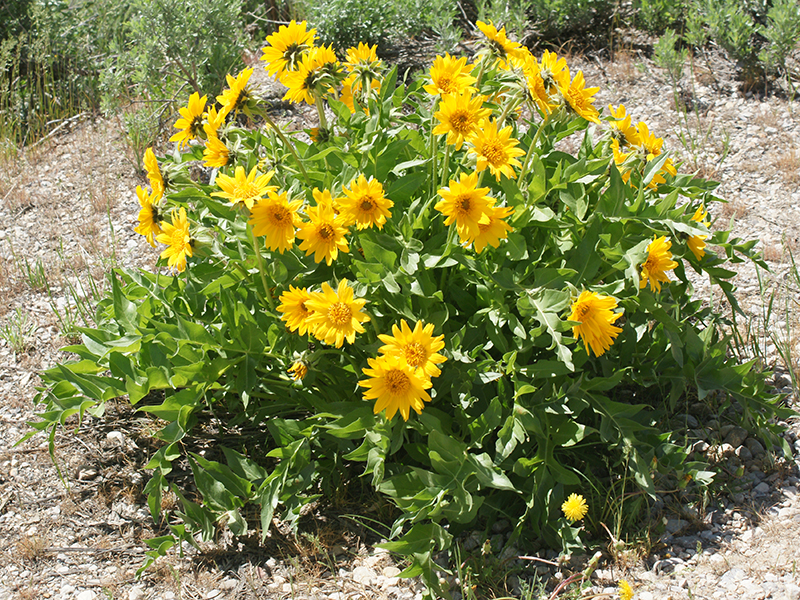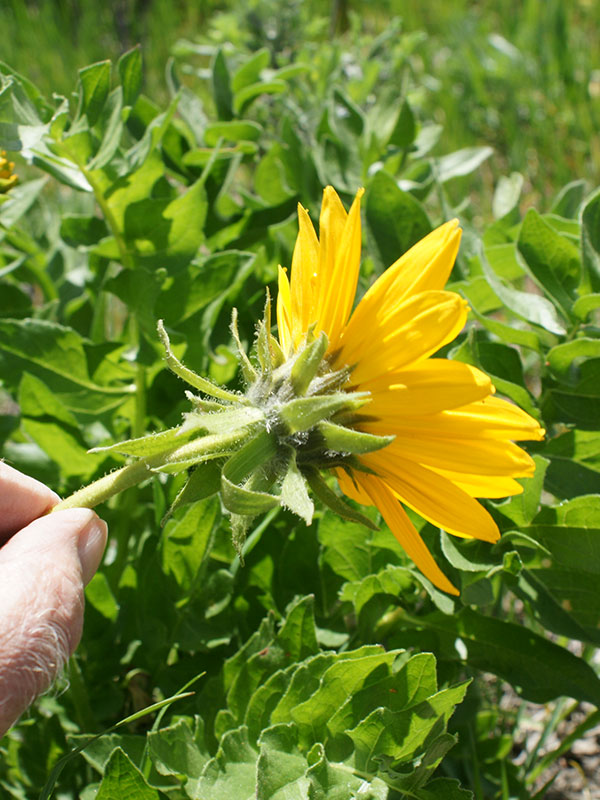Balsamorhiza macrophylla / cutleaf balsamroot
- large, yellow, sunflower-like blossom
- large, dissected/lobed/compound-looking leaves
- up to 40″ tall
- roadsides or hillsides with arrowleaf balsamroot and Wyethia
Also known as: cleft-leaf balsamroot, large-leafed balsamroot, hairy balsamroot
Synonym: B. hookerii
See also: Balsamorhiza sagittata / arrowleaf balsamroot, Wyethia amplexicaulis / yellow mule’s ear
The cutleaf balsamroot is a less well-known cousin of the arrowleaf balsamroot. It has a much more restricted distribution and generally a smaller presence in mixed populations. It is found especially in Idaho, with spillover into northern Utah and Nevada and south-western Montana.
Balsamorhiza macrophylla can get to an impressive size for an herb growing on what looks like pretty bad soil… up to 40 inches tall on sagebrush scrublands and by conifer forests. The lead image in the gallery here was taken on one of the gravelly roads above Pine Creek Pass. Its size probably reflects both its perennial life style and its very large taproot for storing nutrient reserves. Despite this, its mode of reproduction is by seed.
Cutleaf balsamroot has yellow, sunflower-like flower heads, usually borne singly atop a leafless stalk. Both ray florets and disc florets are present. Each flower has long, leafy, hairy bracts that may extend past the edge of the disk.
Basically, the flowers look like those of arrowleaf balsamroot and any number of other related species. The really distinguishing feature is the leaves. These are large (i.e. macrophylla) with deep clefts, or with segments or leaflets whereas the arrowleaf leaves are undivided. Sometimes the leaves are hairy, but the “sometimes” makes this not a very good field mark.
Cutleaf balsamroot is strongly drought resistant and tolerates semi-shade. It is strongly tolerant of grazing and trampling, again probably because of its large taproot and because, like arrowleaf and Wyethia, it dries down to crunchiness by mid-summer. In the spring, grazers will eat it but horses are especially fond of the flowers. Balsamroots in general will increase when (over)grazed by cattle, but decrease when grazed by sheep or deer on winter ranges.
Interesting bits – B. macrophylla evidently arose by hybridization of Balsamorhiza sagittata and B. hispidula. The result was a plant with the multi-branched caudex and massive taproot of B. sagittata and the leaf dissection of B. hispidula (ref). Genomically, the result was that for this species the chromosome number is n = 100+/-2; it is highly polyploid. All other Balsamorhiza species have chromosome numbers ca. n=19. Presumably, the high-polyploid chromosome complement precludes interbreeding with other members of the genus.
| Color | |
|---|---|
| Family | |
| Blossom size | |
| Inflorescence size | |
| Inflorescence type | |
| When? | |
| Where? | exposed, forest gaps and roadsides, higher altitudes, uncommon |



